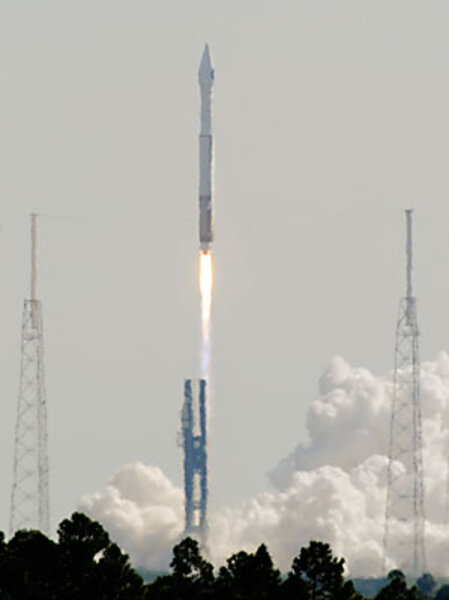NASA launches satellite to help forecast solar storms
Loading...
Scientists and space-weather forecasters have a new ally in their quest to understand and forecast solar storms – events that can disrupt radio communications on Earth, trigger blackouts, and endanger astronauts and satellites in orbit.
At 10:23 a.m. Thursday, NASA launched its Solar Dynamics Observatory (SDO). It's an $856 million mission that will provide the most comprehensive views yet of the sun – from processes at work deep inside the star to sunspots and explosive outbursts of charged particles and radiation from the sun's surface.
These solar storms can affect planets throughout the solar system, including Earth.
The mission is the first in a series of four projects that make up the space agency's “Living With a Star” research program.
Humans have become increasingly reliant on technologies that are vulnerable to solar storms, observes Madhulika Guhathakurta, an astrophysicist and lead program scientist for the “Living With a Star” effort. Even low-tech infrastructure such as oil or gas pipelines at high latitudes can be affected by electrical currents that are triggered by these storms.
The probe NASA lofted Thursday "will revolutionize our view of the sun," Dr. Guhathakurta said during a recent pre-launch briefing.
Insights into universe's plasma
The SDO’s observations won’t just help in understanding space weather better. They can also yield insights into some of the most fundamental processes at work in the universe, suggests Alan Title, one of the mission's lead scientists and senior fellow at the Lockheed Martin Advanced Technology Center in Palo Alto, Calif.
For one, the sun represents a powerful lab for studying the behavior of turbulent plasmas, which generate electrical currents and magnetic fields. “Most of the universe that isn't dark energy or dark matter is plasma,” says Dr. Title, referring to a state of matter that consists of hot, ionized gas.
Moreover, he suggests, the insights scientists gain from studying the behavior of the sun's plasma may help advance efforts to develop power plants on Earth that use sun-like fusion reactions to generate electricity.
More immediately, however, researchers are looking to SDO and its follow-on missions to advance the state of the art in space-weather forecasting.
Researchers say today's space-weather forecasts are on a par with weather forecasting 50 years ago – useful, but they could be far more so. Over time, the data SDO returns is expected to help lengthen lead times for solar-storm forecasts.
There's also demand for predictions of little or no solar activity, researchers say.
“One of the types of predictions that people have told us would be quite useful would be the ability to predict … when the sun would be quiet” up to three days in advance, adds Philip Scherrer, an astrophysicist at Stanford University in Palo Alto, Calif., and the lead scientist for one of the craft's three instruments.
Tools to study the sun
These instruments include one that images the sun's above-surface magnetic fields and probes beneath the sun's surface for a better understanding of the physics behind the mechanisms driving those fields.
A second instrument will measure extreme ultraviolet radiation coming from the sun. This radiation heats the upper atmosphere. Large outbursts can cause Earth's atmosphere to expand outward, increasing the amount of drag on spacecraft in low-Earth orbit, including the International Space Station. Extreme ultraviolet radiation also rips apart molecules in the upper atmosphere, altering conditions in Earth's ionosphere in ways that disrupt radio communications, including signals from GPS-navigation satellites.
Finally, a suite of four telescopes will monitor the sun's surface and atmosphere. They are designed to look at the sun at eight different wavelengths at a time, and return a high-definition image of the sun every 10 seconds. Scientists say this rapid-fire approach will allow them to better dissect the start and spread of solar storms.
The launch comes at a propitious time in the sun's 11-year cycle of activity. Scientists thought they would be launching when solar activity was at its peak. But the quiet portion of the 11-year (average) cycle has stretched out longer than scientists had anticipated, although in the past week, the sun has appeared to be waking up.
Thus, SDO has a chance to track processes on the sun as the cycle intensifies. Mission planners designed the craft with a five-year mission in mind, but it could be extended another five years if the spacecraft holds up well.
---
Follow us on Twitter.





